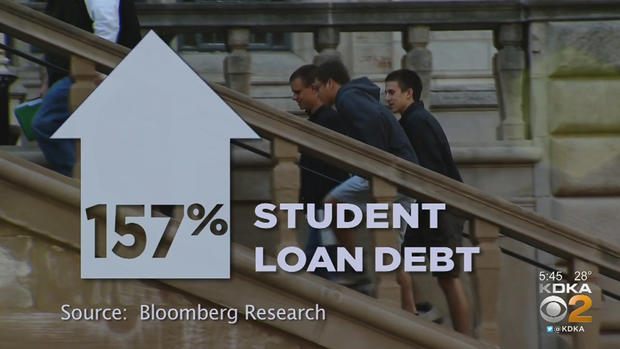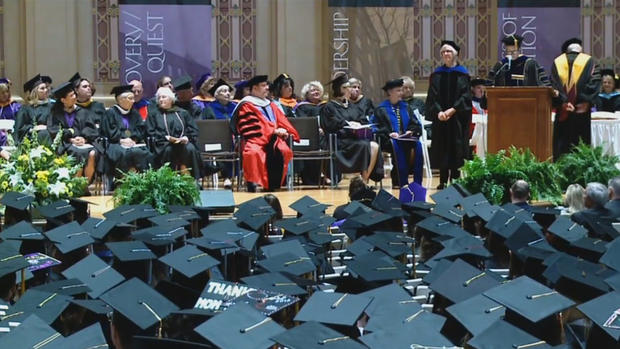Student Debt: How To Get A Higher Education, Learn Marketable Job Skills Without Going Into Debt
Follow KDKA-TV: Facebook | Twitter
PITTSBURGH (KDKA) -- It is no secret college gets more expensive by the year, and students graduate with a ton of student loan debt.
What may be a mystery: how to get an education or to learn marketable job skills without going into debt in the first place. It is not as far-fetched as it sounds.
When it comes to student loans, the numbers are staggering.
Rick Applegate, a certified financial planner at DBR & Company, talks with a lot of students and recent college graduates. He says the numbers he hears are "anywhere from $25,000 to $100,000 of debt to start out in life."
Americans are drowning in more than a $1.5 trillion in student loan debt. Since 2007, Bloomberg Research says student loans have exploded by a whopping 157 percent. Applegate fears it eventually could hinder the American economy. He says many young people don't have the money to do things that their parents did at the same age.
"They are turning 31- and 32-years-old and still carrying $110,000 of debt behind them. That's when it starts to squeeze them on future financial decisions," Applegate said.
It is becoming more than just an economic issue. It is becoming a social issue, too. Many students are now forced to move back home after graduation from college as they can't afford to pay their loans and find a place of their own that they can afford.
"They are staying there [their parents' home] for long periods of time," Applegate said. "We are seeing marriage rates drop. We are seeing newborn children rates drop because they can't afford to have kids. So there are a lot of things changing societally that we have to be aware of because of this problem."
A lot has changed since Sima Misquitta started working as a guidance counselor at Baldwin High School 24 years ago.
"We were told, 'Go to your dream college. Don't worry about how much it costs,'" Misquitta says. "That is not the message anymore."
Caroline Babik is also a high school counselor who works with Misquitta at Baldwin High School. She also sees the problem firsthand every day.
"Everyone said, 'Go to college. Go to college. That equals success.' It did then, but now things are changing." She paused, "Now our trades are excessively in demand."
That fact alone could help thousands of students every year avoid the pitfalls of massive student debt at the end of a traditional trip to college.
Only 36 percent, roughly a third, of all college students are able to graduate from college in four years. Additional years in college to complete a degree means even more debt. And there is a more significant problem.
"Fifty percent of students drop out of college, and then they have all this debt and no degree. No skills," says Misquitta. "They will spend decades possibly paying off this debt" and never have a degree to show for it.
So how do you avoid this financial pitfall, or help your kids and grandchildren from doing the same?
"How about be a physical therapy assistant first?" suggests Babik. "Go to school for two years. Make $40,000 a year at 21, and let them help you pay to go to back to school."
It is a strategy know as building stackable skills. Use your first skill to pay for the second skill you want to earn, and so on. It doesn't take long for it to pay big dividends.
Misquitta knows of one South Hills student who did exactly that with impressive results.
"He barely made it through high school. He got a job with a local electric company, and they trained him on the job." She smiled when she said, "He's making almost six figures now."
He never went to college. He has no college debt.
There is another easy way to slice into college costs? Go to a community college for the first two years and live at home. If you still think you need a four-year degree, you can always transfer after two years to your dream school.
Misquitta calls it "the best financial aid out there. You are cutting tens of thousands of dollars off of your student debt."
Consider this example for a student from Allegheny County. If a student enrolls full-time at CCAC, the annual tuition are a little more than $4,100 per year. Books are estimated to be another $1,200 per year. Add in fees and the total comes in right around $6,200 per year.
Compare that to a student who picks the University of Pittsburgh and wants to live in the dorm. Tuition, fees, room and board at Pitt will cost $30,662 (assuming a double room and the average meal plan on campus.) That is approximately five times more than earning credits through CCAC.
If the same student chooses a private college like Allegheny College in Meadville, Pennsylvania, or Dickinson College in Carlisle, Pennsylvania, that figure can easily skyrocket to more than $60,000 per year – about ten times the annual cost of earning college credits at CCAC.
(NOTE: None of these examples include financial aid. Scholarships and grants are available for many students based on academic ability, SAT/ACT test scores, and the family's financial need.)
If you decide to transfer from community college after two years, your degree and diploma will be issued by the school where you finish. In other words, you will hold the same Pitt or Penn State or Slippery Rock diploma as the students who went there for four or five years to earn their degree.
There could be another noticeable benefit of going the community college route, especially if you decide to transfer to a four-year college. You may get into a better school after a couple years later than if you had gone to a four-year college right out of high school.
"Now they are looking at who are you as a transfer student, not who you were as a high school student," says Babik. "That could end up helping in the form of additional financial aid or grants that you won't have to pay back."
A lot has changed in the past 30 or 40 years since the Baby Boomers graduated from high school and went straight to college. Years ago, high school juniors or seniors would walk into the career and college planning center or talk to their guidance counselor. They would pick up a book that outlined something like "Best Buys in College Education."
Misquitta and Babik are solidly in agreement on this fact: Today, the best buys may not be a college education. It could be something else -- especially with the pressing need for skilled tradesmen and women.
"Trade schools of course are a great option," says Misquitta.
Babik adds, "Going into the union is another choice. Bidwell Training Center offers free training for graduates. There is Job Corps which will also pay for community college."
She says if those aren't appealing, "Don't forget the military. They, too, will pay for college for those who enlist and serve."
Let's get back to the financial planner Rick Applegate. What is his best advice on dealing with student loan debt. He says it is simple. Don't go in debt in the first place. Work two jobs if you have must. Take a couple years off and save all your money to pay tuition. Work summers, too.
"If you want it bad enough, you are going to do it [work to pay for school]," says Applegate. "But you have to find a way to make sure that you think ahead and plan for what you are stepping into."





